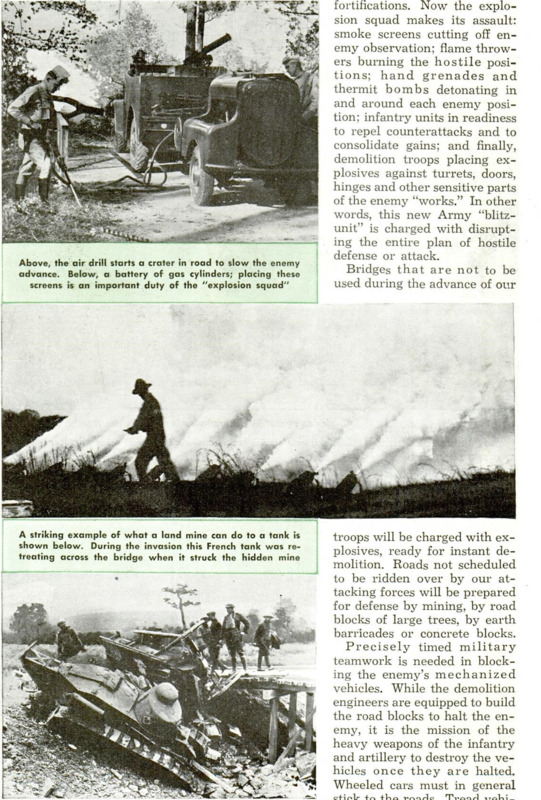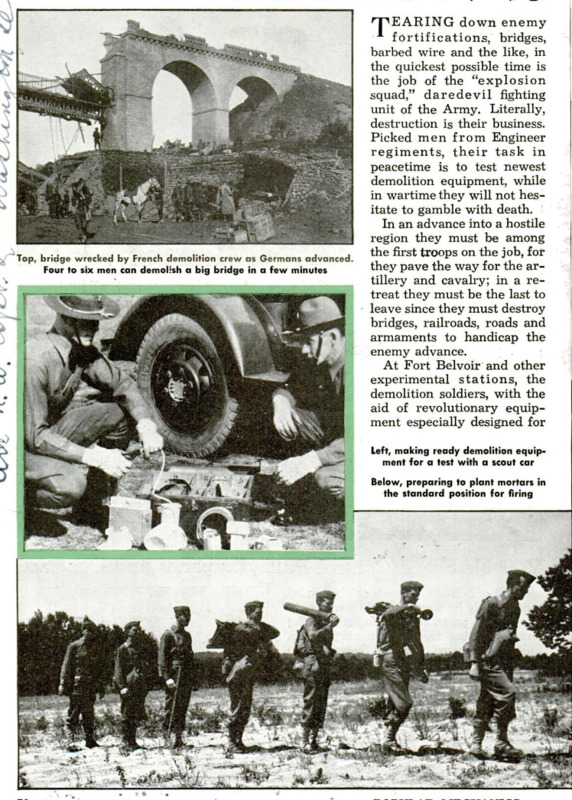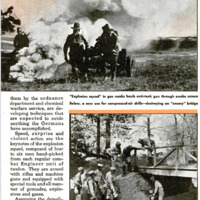TEARING down enemy fortifications, bridges, barbed wire and the like, in the quickest possible time is the job of the “explosion squad,” daredevil fighting unit of the Army. Literally, destruction is their business. Picked men from Engineer regiments, their task in peacetime is to test newest demolition equipment, while in wartime they will not hesitate to gamble with death. In an advance into a hostile region they must be among the first troops on the job, for they pave the way for the artillery and cavalry; in a retreat they must be the last to leave since they must destroy bridges, railroads, roads and armaments to handicap the enemy advance. At Fort Belvoir and other experimental stations, the demolition soldiers, with the aid of revolutionary equipment especially designed for them by the ordnance department and chemical warfare service, are developing techniques that are expected to outdo anything the Germans have accomplished. Speed, surprise and violent action are the keynotes of the explosion squad, composed of four to six men hand-picked from each regular combat Engineer unit of twelve. They are armed with rifles and machine guns and equipped with special tools and all manner of grenades, explosives and gases. Assuming the demolition specialists are called upon to aid in assaulting an enemy stronghold, here’s the procedure: First the air corps and heavy artillery bombard the area, crippling major fortifications. Now the explosion squad makes its assault smoke screens cutting off enemy observation; flame throwers burning the hostile positions; hand grenades and thermit bombs detonating in and around each enemy position; infantry units in readiness to repel counterattacks and to consolidate gains; and finally, demolition troops placing explosives against turrets, doors, hinges and other sensitive parts of the enemy “works.” In other words, this new Army “blitz-unit” is charged with disrupting the entire plan of hostile defense or attack. Bridges that are not to be used during the advance of our troops will be charged with explosives, ready for instant demolition. Roads not scheduled to be ridden over by our attacking forces will be prepared for defense by mining, by road blocks of large trees, by earth barricades or concrete blocks. Precisely timed military teamwork is needed in blocking the enemy’s mechanizedvehicles. While the demolition engineers are equipped to build the road blocks to halt the enemy, it is the mission of the heavy weapons of the infantry and artillery to destroy the vehicles once they are halted. Wheeled cars must in general stick to the roads. Tread vehicles can only make speed off the roads when the terrain is favorable. Armored cars of both kinds are hard to hit with sufficiently heavy guns when traveling 40 to 50 miles an hour. Therefore it is the job of the explosion squad to halt mechanized forces so they can be destroyed by heavy fire of our infantry and artillery. In this work the “land mine” is helpful. A charge of 10 pounds of high explosive in a mine is sufficient to smash any wheel or tread vehicle which will detonate it. Small and easily and quickly handled, it can be buried in open spaces or hidden by underbrush. When a vehicle passes over this type of mine, it explodes immediately. Military experts believe a sufficiently large supply of Jland mines, adequately covered by anti-tank weapons, will go far toward preventing spectacular advances such as German mechanized units achieved in Holland, Belgium and France. Not only do the members of the explosion squad destroy, but they rebuild and repair. Roads and bridges blocked or demolished by the enemy must be made ready for our troop advances. Without the demolition engineers, any dash of our armed vehicles to the front, or on sweeps around the enemy flanks, would be difficult or impossible. Other vital jobs are: penetrating barbed wire; helping consolidate territory gained; extending routes of communication into captured territory; and supplying the usual engineer material, notably pure drinking water and sanitation facilities to troops on the march. In the case of railroads, demolitions are especially effective. An enormous amount of track can be demolished in a few minutes by explosion crews of four to six men. War Department scientists are now performing countless tests with incendiaries, which are directed primarily against buildings and equipment and in major assaults on fortifications.” White phosphorus, primarily a smgke producer, with the property of igniting spontaneously and burning vigorously when exposed to air, is one of the best incendiary materials. When scattered from overhead by grenades and trench mortar bombs, the phosphorus rains down in flaming particles which stick to clothing and cannot be easily brushed off or quenched. Phosphorus always causes a demoralizing effect far beyond the actual casualties it produces. Another spectacular explosive is thermit, a mixture of iron oxide and finely divided aluminum. When ignited it produces an enormous heat and therefore makes excellent incendiary bombs. Warring nations claim great success with thermit mixed with sulphur as an incendiary bomb. New air-compressor equipment has been developed for use of the demolition engineers. Tools included are an air drill, air saw, air shovel and pavement breaker. The drill and pavement breaker can penetrate the hardest concrete in a bridge or road; the saw will cut through strongest timber, whether it be a tree, road block or part of a bridge; the shovel removes debris with remarkable ease. Several new methods for penetrating barbed wire entanglements have been developed. Wire cutting with torpedoes is fairly effective but it is too slow and requires too much manpower. A better system involves the use of chicken wire. Three-foot lengths are wrapped in heavy burlap, and when a section of barbed wire is encountered, explosion troops simply drop a number of these heavy mats on the wire and it falls harmlessly to the ground. A new trench mortar promises to be ideal as a high-angle, short-range weapon to assist the advance of the infantry for meeting the “enemy” at close quarters. It concentrates fire on machine-gun areas which, because of irregularities of the terrain, cannot be reached by flat-trajectory weapons. Two main sizes are available in the new mortar - 60 mm. and 81 mm.






